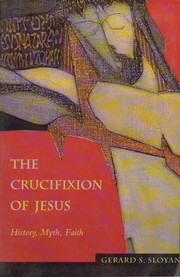
The crucifixion of Jesus
By Sloyan, Gerard Stephen, Susannah Heschel, Robert P Ericksen
Subjects: Role of Jews, Crosses, Soteriologie, Judaism (christian theology), Jewish role in the Passion of Jesus Christ, Jesus christ, passion, National socialism and religion, Religion, Judaism (Christian theology), Cult, "Bible. NT", Jésus-Christ, Causes, Crucifixion of Jesus Christ, Kruisiging, Kreuzigung, Holocaust, Jewish (1939-1945), Crucifixion, Church and state, Crucifiement, Croix, Holocaust, jewish (1939-1945), National socialism, Mort, Jesus christ, crucifixion, Culte, Church and state, germany, Satisfaction (Théologie), History, Satisfaction for sin, Christianity and antisemitism, Antisemitism, Passion, Sotériologie, Germany, religion, Rôle des Juifs
Description: Jesus of Nazareth died on a cross at the hands of Roman justice around the year 30 C.E. Thousands of others perished in the same way, and many people before and since have suffered far more gruesome torments. Why then is Jesus, Gerard Sloyan asks, uniquely and universally remembered for his suffering death? How has his death brought solace to many millions? To answer this question, Gerard Sloyan in this powerful historical tour de force tracks the legacy of the cross across two millennia of Christian reminiscences, piety, art, speculation, and mythicizing. Beginning with New Testament accounts, he shows how Jesus' death came to be seen as sacrificial. He then plots the emergence and development -- in theology, liturgy, literature, art -- of the conviction that Jesus' death was redemptive, as seen both in soteriological theory from Tertullian to Anselm, in the Reformation and modern eras, and in more popular religious responses to the crucifixion. - Back cover.
Comments
You must log in to leave comments.